Effective Extermination of Outdoor Flies


Intro
Flies can be a major nuisance when spending time outdoors. Their presence can ruin picnics, backyard parties, or simply moments of relaxation. While many attempt to manage fly populations with home remedies, the effectiveness of these methods can vary greatly. This article explores whether exterminators can effectively eliminate flies in outdoor settings. By examining the behavior of these pests, methods used by professionals, and ways to prevent infestations, homeowners can gain a clearer understanding of how to tackle this issue effectively.
Understanding the Pest
Identification
There are various species of flies that may invade outdoor areas, each with distinctive characteristics. Common flies include the housefly, fruit fly, and horsefly. The housefly is often found around decaying organic matter, such as trash or compost. Fruit flies are attracted to ripe or fermenting fruits and vegetables. By knowing which species are present, it becomes easier to determine suitable control measures.
Life Cycle
Understanding the life cycle of flies is crucial. Most adult flies lay hundreds of eggs, which hatch within a day or two. The larvae, or maggots, feed voraciously on organic material before pupating. This cycle can occur rapidly, with some species completing their life cycle in just a week. This fast reproduction rate means that fly populations can explode quickly if not addressed promptly.
Pest Prevention Strategies
Environment Modification
One effective way to manage flies outdoors is through environmental modification. Here are some strategies:
- Regular cleaning: Remove organic waste and trash promptly. Keep compost bins closed.
- Standing water: Ensure there is no standing water in gardens or bird baths, as this attracts flies.
- Limit food exposure: During outdoor gatherings, cover food to minimize attraction.
Physical Barriers
Combining environment modification with physical barriers can fortify outdoor areas against flies. Using screens on porches or nets over food can be effective in preventing flies from invading social spaces. Additionally, natural repellents like citronella candles can deter their presence.
Control Methods
Chemical Control
When flies become a persistent problem, chemical control may be employed. Exterminators often use targeted insecticides designed to disrupt the life cycle of flies. Some popular chemical agents include pyrethroids and neonicotinoids. The application method may vary, from sprays to bait stations, depending on the fly species involved. However, care must be taken regarding the environmental impact of these substances.
Biological Control
Biological control involves the use of natural predators to manage fly populations. Certain parasitoids, like wasps, target fly larvae and can help reduce their numbers. This method is especially useful in larger outdoor settings, allowing for a more balanced approach to pest management without heavy reliance on chemicals.
"Understanding both the behavior of flies and the various control methods is essential for successful outdoor pest management."
Preamble to Outdoor Fly Problems
Outdoor fly problems can disrupt the comfort of your home and impact your quality of life. These pests are not just a nuisance but can also pose health risks and damages to property. Understanding the specific types of flies that frequent outdoor areas is crucial for effective management. This article will explore how exterminators tackle this issue.
Understanding Common Outdoor Flies
Common types of outdoor flies include house flies, fruit flies, and horse flies. House flies are typically found near human dwellings, attracted to food waste and garbage. Fruit flies prefer decaying fruits and vegetables, often found around gardens or composting areas. Horse flies, larger and more aggressive, can impact outdoor activities and leisure.
Understanding these different species helps in identifying the best control methods. Each fly type exhibits unique behavior patterns which influence where they breed and feed. By recognizing their habits, homeowners can address problems before they escalate.
Recognizing the Need for Extermination
Identifying when to call for professional extermination is essential. Signs of a fly problem can include an excessive number of flies around your property, the presence of larvae or eggs, and the odor associated with their breeding sites. Sanitation problems often lead to fly infestations, making it vital to act promptly.
Extensive fly populations can undermine outdoor gatherings and activities. Moreover, they may contaminate food and transmit diseases. Understanding the risk involved underscores the need for an effective extermination strategy. Exterminators possess the expertise and tools necessary to assess and address fly infestations in a targeted manner.
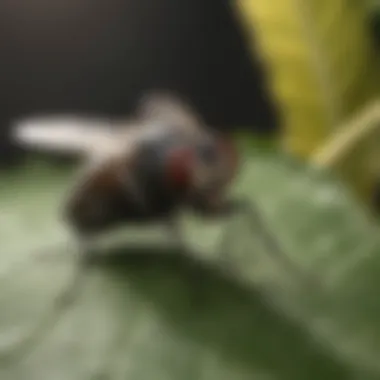
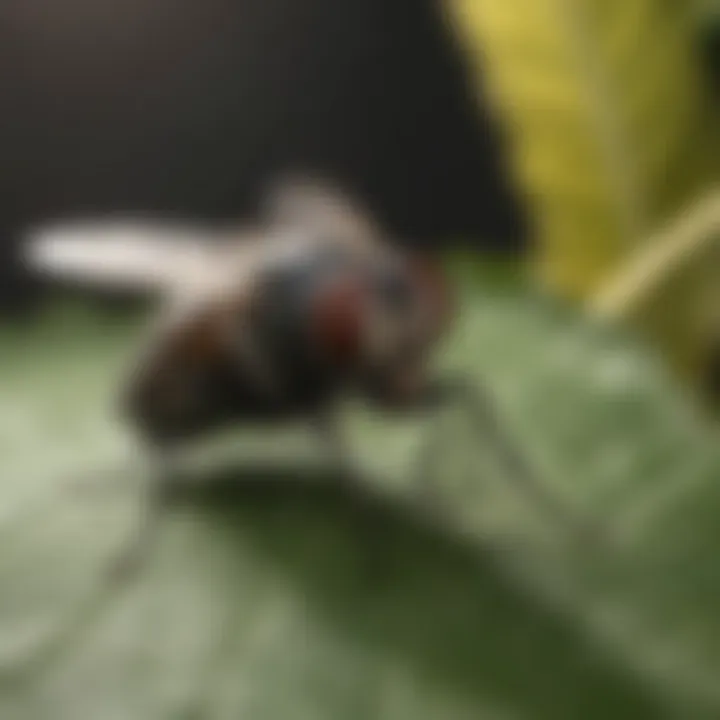
Role of Exterminators in Fly Management
To understand how exterminators tackle the issue of flies outside, it is crucial to recognize their role in effective fly management. Flies are not merely a nuisance; they can carry diseases which can affect households, pets, and livestock. Therefore, a professional approach often becomes an appropriate response to these infestations. Exterminators bring a wealth of knowledge and practical experience to the table, which enables them to address fly issues with precise strategies tailored to the specific situation.
The benefits of employing exterminators cannot be understated. They not only offer immediate solutions but also provide long-term strategies aimed at preventing future fly problems. By using advanced techniques and understanding environmental factors, exterminators can ensure a more comprehensive approach to fly management in outdoor areas.
Attention to specific elements such as fly species identification and their behavioral patterns forms the foundation of the extermination process. Also, exterminators educate homeowners on maintaining hygiene and environmental practices that deter fly infestations, thus fostering a collaborative effort in managing these pests.
Expertise of Pest Control Professionals
The expertise of pest control professionals extends beyond mere elimination of flies. They are trained to observe different fly species, assess their habitat preferences, and understand their life cycles. This knowledge is essential, as it allows them to implement targeted control measures and apply treatments more effectively. For instance, house flies, fruit flies, and horse flies each have distinct habits and vulnerabilities.
In dealing with outdoor fly problems, exterminators often start with a thorough inspection of the area. They identify potential breeding sites, which may include standing water, poorly managed waste, or decomposing organic material. After the assessment, a tailored plan is developed, which may involve various treatment methods suited for the specific type of fly infestation present.
Pest control professionals also stay updated on the latest methods and regulations in pest management, which enhance their operational efficiency and compliance with standards. By applying their expertise to real-world problems, they provide a dependable resource for homeowners facing fly control challenges.
Assessing the Extent of Infestation
Assessing the extent of an infestation is a vital step in effectively managing flies. Exterminators utilize a systematic approach during this phase. They initially evaluate the size of the infested area and the presence of flies, noting their numbers and behavior patterns. A detailed inspection helps identify the breeding sources and feeding locations.
They will often look for signs of infestation, such as:
- Visible fly clusters
- Larvae in waste or decaying matter
- Foul odors that may indicate decomposing organic substances
Understanding the scope of the infestation allows exterminators to gauge the level of intervention necessary. A minor issue might require just a few treatments, while a major infestation could necessitate multiple strategies and ongoing monitoring. Knowing the extent of the problem helps customers manage their expectations and prepares them for the necessary steps ahead. Moreover, assessing the extent frequently involves interaction with the homeowner, gathering additional information on activities, cleanliness, and any previous eradication attempts.
By establishing a detailed picture of the infestation's nature and severity, exterminators can deploy the most effective strategies to eliminate flies and reduce the likelihood of their return.
Methods Employed to Remove Flies
The complex issue of outdoor flies necessitates effective and varied removal methods. The methods employed by exterminators not only address existing infestations but also aim to minimize future occurrences. This article outlines several key techniques used to combat outdoor flies, focusing on chemical treatments, biological control methods, and physical solutions. Understanding these methods can help homeowners appreciate the breadth of options available for effective pest management.
Chemical Treatments
Chemical treatments remain a primary approach in extermination efforts. These methods involve the application of insecticides specifically formulated to target flies. Exterminators select products carefully based on the type of fly, environmental safety, and effectiveness.
- Types of Chemical Insecticides: Common categories include pyrethroids, organophosphates, and insect growth regulators. Each has unique characteristics and targets flies at various life stages. Pyrethroids, for instance, are favored for their rapid knockdown effect, while growth regulators disrupt the lifecycle, preventing reproduction.
- Precision in Application: Professional pest control services use equipment that ensures precise application. This minimizes exposure to non-target organisms, making the method safer for pets and humans. Proper licensing and training are fundamental for successful chemical treatments, ensuring that products are used within regulatory guidelines.
- Considerations of Resistance: Over-reliance on chemicals can lead to resistance among fly populations. Educated exterminators balance chemical applications with other approaches to maintain efficacy. Promptly addressing resistant flies is crucial for sustainable management.
"Insecticides are effective but must be integrated into broader strategies. This ensures long-term effectiveness against outdoor fly problems."
Biological Control Methods
Biological control represents a natural and environmentally friendly approach to fly management. This method utilizes the natural enemies of flies, such as parasites, predators, or pathogens, to reduce their populations.
- Natural Predators: Certain species of wasps and spiders are known to prey on flies. Exterminators may encourage these populations in outdoor spaces to provide ongoing fly control. Understanding local ecosystems is essential for successfully integrating predators.
- Microbial Control: Utilizing bacteria such as Bacillus thuringiensis can effectively target flies while minimizing harm to beneficial insects. This type of method is particularly advantageous in landscapes where chemical applications may pose risks.
- Implementing Safe Practices: Biological control methods can be combined with habitat manipulation to enhance effectiveness. This might include altering environmental conditions to make them less hospitable for flies, thereby reducing their populations naturally over time.
Physical and Mechanical Solutions
Physical and mechanical solutions focus on tangible methods that physically eliminate flies or deter them from establishing in outdoor areas. This approach can be particularly helpful in conjunction with chemical and biological methods.
- Traps: Various types of fly traps can be employed, including sticky traps, bait traps, and electric traps. Each serves to capture flies effectively, reducing their numbers in a targeted area. They can be positioned strategically based on fly behavior patterns to maximize efficiency.
- Exclusion Techniques: Implementing barriers such as screens, nets, and mesh covers can effectively prevent flies from accessing areas where food or waste is present. This method costs less in the long run by reducing the need for reactive treatments.
- Regular Maintenance: Physical measures are most effective when combined with regular inspections and maintenance. This includes cleaning waste areas, managing compost, and ensuring that garbage is properly contained.
Combining various methods enhances the overall effectiveness of fly removal strategies. Each method serves unique roles in fly management, allowing homeowners to approach the problem holistically. Through understanding these diverse methods, individuals can make informed decisions when dealing with outdoor fly infestations.
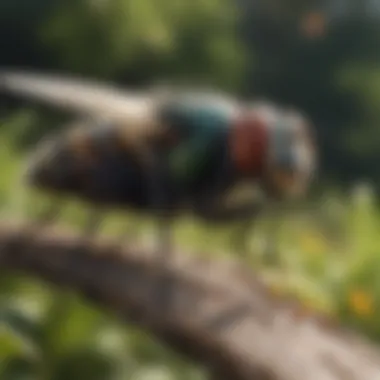
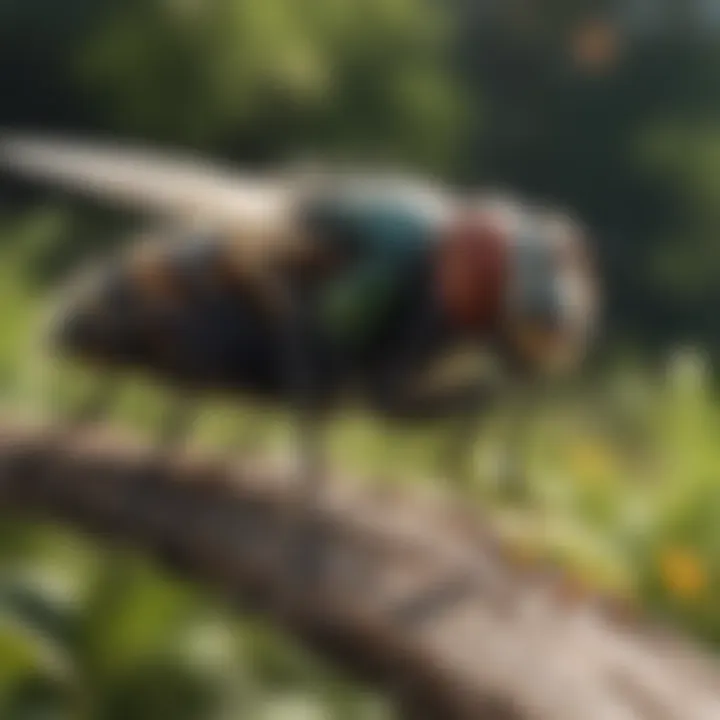
Factors Affecting Fly Control Efficacy
Understanding the factors that influence the efficacy of fly control is crucial for anyone dealing with outdoor fly infestations. This knowledge helps homeowners and pest control professionals alike devise more effective strategies. Several key elements come into play, including environmental aspects, seasonal variations, and the life cycle and behavior of flies. Each factor can significantly impact the methods used for control and the overall success of extermination efforts. Addressing these considerations can lead to better outcomes in managing fly populations in outdoor settings.
Environmental Considerations
The specific environment where flies inhabit plays a significant role in how effective extermination measures will be. Flies thrive in certain settings that provide them with food, breeding opportunities, and shelter. Areas with excess moisture, decaying organic matter, or animal waste often attract various fly species.
For instance, compost heaps, garbage bins, and open pet food can serve as breeding grounds that exacerbate fly problems. Moreover, natural predators and competing species in the area can either mitigate or worsen fly populations. It’s important to assess local environmental conditions before applying any pest control tactics. Effective management may involve adjusting these habitats to discourage flies while promoting beneficial insects.
Time of Year and Seasonality
Seasonal changes are another critical factor in fly control. Different fly species exhibit varying activity levels throughout the year. Warmer months often see increased fly activity, leading to more infestations. Certain species, like house flies and blow flies, are prevalent in hot weather. During cooler months, some flies become dormant.
Being aware of these patterns can enhance control strategies. For instance, proactive measures taken in early spring may prevent larger fly populations later in the season. Timing chemical treatments or biological control measures during peak activity can increase their effectiveness. Therefore, understanding the seasonal dynamics of fly behavior is essential for maximizing the success of extermination efforts.
Fly Lifecycle and Behavior
To effectively control fly populations, knowledge about their lifecycle and behavior is vital. Flies typically go through four major stages: egg, larva (maggot), pupa, and adult. Each phase presents unique vulnerabilities. For example, targeting the larval stage is often more effective since that is when they are most damaging and numerous.
Flies are also influenced by environmental cues such as temperature, light conditions, and food availability. It’s important to note that adult flies can reproduce quickly, with females laying hundreds of eggs at a time. This rapid reproduction means that small infestations can escalate into significant problems if not addressed promptly.
Alternatives to Professional Extermination
In the context of maintaining outdoor spaces free from flies, exploring alternatives to professional extermination is crucial. Many homeowners may prefer to avoid chemical treatments or the expense associated with hiring pest control services. Understanding various options allows individuals to choose methods that fit their lifestyle and values.
Several elements are important when considering these alternatives. The first is safety; many people have concerns about chemical residues affecting family members or pets. Moreover, there is a growing interest in sustainable practices, which has prompted some to look for eco-friendly pest control methods.
Utilizing DIY fly control techniques and environmentally conscious approaches can be highly effective. These strategies not only help in managing fly populations but also encourage ongoing preventive measures.
*
DIY Fly Control Techniques
For homeowners interested in tackling fly issues themselves, there are several effective DIY control techniques available. These methods offer an affordable and readily accessible way to manage flies without professional intervention. Here are some techniques to consider:
- Fly Traps: Simple traps can be made using common household items. For instance, a mixture of vinegar and dish soap attracts flies while the soap prevents them from escaping once they land.
- Essential Oils: Certain essential oils are known to repel flies. Peppermint, eucalyptus, and lavender oil can be used in diffusers or diluted with water and sprayed around outdoor areas.
- Homemade Sprays: A mixture of water, vinegar, and a few drops of dish soap can serve as an effective spray solution against flies. Applying this mixture to surfaces where flies gather can significantly reduce their presence.
- Natural Baits: Utilizing natural baits like fruit scraps or honey traps can also lure flies into controlled environments where they can be easily trapped.
These methods are not only economical but also allow one to engage actively in pest management without relying on external services.
Eco-Friendly Approaches
Utilizing eco-friendly approaches is becoming a preferred choice for many households aiming to maintain outdoor spaces sustainably. Emphasizing natural solutions can minimize environmental impact while effectively managing fly populations. Here are some eco-friendly strategies to consider:
- Planting Repellent Herbs: Certain herbs like basil, mint, and rosemary can naturally repel flies. Incorporating these plants in gardens or around patios can create a barrier against unwanted insects.
- Improving Drainage: Flies are often attracted to standing water, which serves as a breeding ground. Ensuring proper drainage in outdoor areas can help reduce fly populations.
- Composting Wisely: While compost bins can be beneficial, they can also attract flies if not managed properly. Regularly turning compost and excluding certain food scraps can make it less appealing to flies.
- Using Fermentation: In some cases, using fermented mixtures of fruit scraps can create a strong attractant for flies, which can then be trapped. This technique is both clever and minimizes waste.
By opting for these eco-friendly solutions, homeowners contribute positively to their environment while effectively managing fly populations.
Preventative Measures for Outdoor Areas
Preventative measures for outdoor areas are crucial in maintaining a fly-free environment. Flies can quickly become a nuisance, affecting outdoor activities and potentially spreading diseases. Implementing proactive strategies can reduce the likelihood of infestations. Not only do these actions enhance the livability of outdoor spaces, but they also minimize reliance on chemical extermination methods.
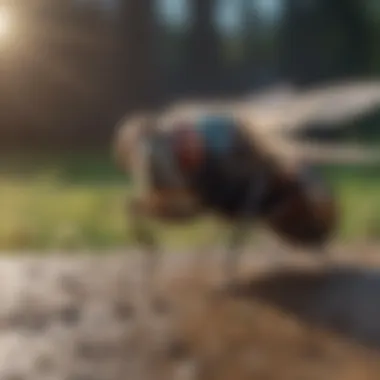
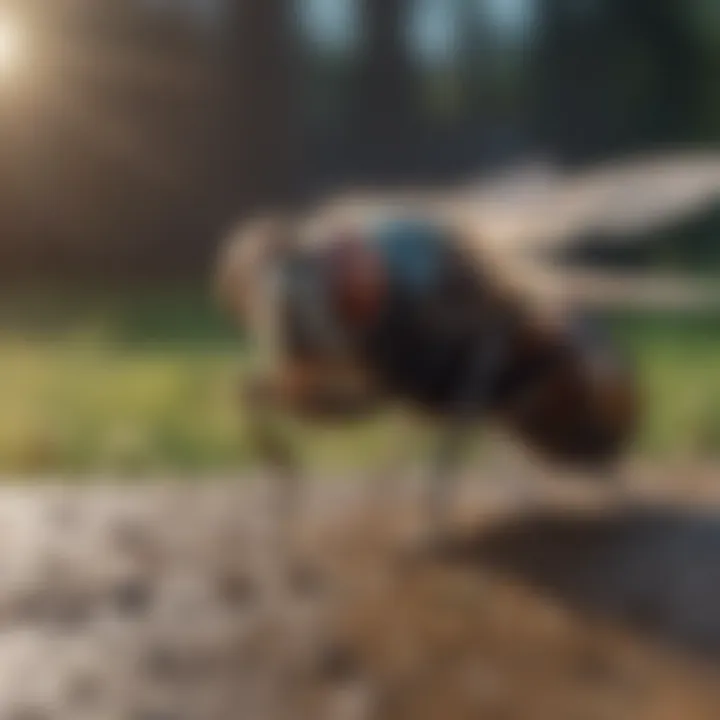
Enhancing Cleanliness
Cleanliness is a fundamental aspect of fly prevention. Flies are attracted to food residues and organic waste. Regular cleaning of outdoor areas, including patios and yard spaces, is essential. Here are some key practices to consider:
- Regularly Remove Food Waste: Ensure that any food remnants from picnics or barbeques are disposed of promptly.
- Clean Up Spills Immediately: Any spills, particularly sugary drinks, should be wiped up without delay.
- Maintain Outdoor Equipment: Ensure grill areas and dining tablets are cleaned after use.
Enhancing cleanliness helps disrupt the fly lifecycle. By removing potential breeding sites, the attraction for flies decreases significantly.
Effective Waste Management
Effective waste management goes hand in hand with cleanliness. Flies are often drawn to garbage can and compost bins. Here are some strategies:
- Use Tight-Fitting Lids: Ensure trash cans are sealed tightly. This prevents flies from accessing the waste inside.
- Frequent Waste Disposal: Regularly empty outdoor waste bins to prevent overflow and odor.
- Compost Wisely: If composting, consider a closed compost system to limit access by flies.
Implementing these waste management practices will minimize breeding grounds and reduce the fly population in outdoor spaces.
Fly-Resistant Landscaping
Landscaping choices can also contribute to the prevention of flies. Specific plants can deter flies, and smart landscaping can help manage not just appearance but also pest control. Consider these elements:
- Plant Repellents: Integrate plants like basil, lavender, or marigolds that naturally repel flies.
- Optimize Drainage: Poor drainage can create stagnant water, attracting flies. Ensure your landscape has proper drainage to avoid pooling water.
- Strategic Plant Placement: Position plants with strong scents near dining areas to keep flies at bay.
By focusing on fly-resistant landscaping, homeowners can create an aesthetic appeal while effectively managing outdoor fly populations.
In summary, the integration of cleanliness, effective waste management, and strategic landscaping creates a holistic approach to managing flies outdoors. The emphasis should be on proactive measures that enhance outdoor living without relying solely on extermination efforts.
Evaluating Long-Term Fly Management Strategies
Long-term fly management strategies are critical in ensuring that outdoor spaces remain free from infestations. The discussion around these strategies integrates several elements that contribute to their effectiveness. The advantages of a robust approach extend beyond the immediate need for extermination. It encompasses sustainability and the prevention of future infestations. Homeowners should recognize that the efforts they invest in thorough fly management yield not only a cleaner environment but also better enjoyment of their yards.
Integrating Pest Control Techniques
Integrating various pest control techniques is essential for effective long-term fly management. This means blending chemical methods, biological control, and physical barriers in ways that complement each other. For example, using insect baits may attract flies away from outdoor areas while also eliminating breeding sites. Concurrently, utilizing insect-repelling plants can add a layer of natural defense to yards.
The combination of techniques also aims to minimize the use of harsh chemicals, aligning with eco-friendly values that many homeowners now prioritize. Additionally, collaborating with pest control professionals can help create a tailored approach that targets specific fly populations effectively. Such integration leads to better control over the factors contributing to fly infestations, thereby reducing reliance on extermination treatments over time.
Outcomes of Ongoing Monitoring
The outcomes of ongoing monitoring play a vital role in the success of any long-term strategy. By observing pest presence and behavior, homeowners can identify patterns that may lead to infestations. Monitoring not only highlights problem areas but also informs whether the current strategies are effective. A simple visual inspection or the use of traps can provide insights into fly populations.
"Regularly assessing outdoor environments helps identify breeding sites and fly activity, making management strategies proactive rather than reactive."
Moreover, maintaining a log of observed changes assists in understanding seasonal fluctuations in fly behavior, allowing for timely interventions. Professionals often employ this monitoring to adjust their strategies, ensuring that they remain effective despite changing environmental conditions.
Culmination
The discussion surrounding the efficacy of exterminators in managing outdoor fly populations holds significant weight for homeowners seeking solutions. This article highlights various aspects related to professional extermination and gives a broad overview of factors influencing both the effectiveness of treatments and long-term strategies for prevention. Understanding the role of pest control professionals provides insight into the complexities of dealing with outdoor flies and the potential benefits of hiring experts.
Flies can often pose health risks and nuisance to outdoor spaces, making it imperative to address infestations promptly. Engaging exterminators not only involves effective eradication methods but also ongoing maintenance to reduce re-infestation chances. Existing insights into different control techniques—from chemical and biological methods to physical interventions—demonstrate the rich tapestry of choices available for managing outdoor fly populations. Each technique presents distinct advantages and considerations depending on the specific environment and type of flies encountered.
Furthermore, recognizing the environmental implications of each method can guide homeowners to make informed decisions that align with their sustainability goals. By integrating professional services, DIY techniques, and preventive strategies, one can create a comprehensive approach to fly management that is effective and ecologically sound.
Thus, it is crucial to evaluate not only the immediate outcomes but also the long-term practices that ensure a fly-free outdoor environment. The interplay between professional extermination and homeowner responsibilities ultimately shapes the quality of outdoor living spaces.
Final Thoughts on Professional Extermination
When considering professional extermination, it's essential to weigh the immediate benefits against the potential long-term investment. Not all fly problems can be solved with a single treatment. Ongoing monitoring, assessment, and adaptations to the strategies used are necessary for sustained control.
Moreover, acknowledging local environmental factors and personal preferences can help tailor an extermination plan that fits specific circumstances. Homeowners should also engage in discusions with pest control specialists to understand how various methods could impact their outdoor spaces.
Many professional exterminators offer consultations where they provide a thorough assessment and recommend tailored solutions. This can make a significant difference in successfully eliminating flies and preventing future infestations. Engaging knowledgeable experts can ultimately lead to a more livable space, conducive to enjoyable outdoor experiences.







